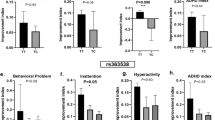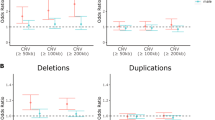Abstract
Attention deficit hyperactivity disorder (ADHD) is a highly heritable and heterogeneous disorder, which usually becomes apparent during the first few years of childhood. Imbalance in dopamine neurotransmission has been suggested as a factor predisposing to ADHD. However, evidence has suggested an interaction between dopamine and serotonin systems in the pathophysiology of the disorder. Studies using selective agonists of the different 5-HT receptors microinjected into selected brain structures have shown a positive modulating effect on the functional activities of the mesotelencephalic dopaminergic system. This suggests that some of the genetic predisposition to ADHD might be due to DNA variation at serotonin system genes. In this study, we investigated polymorphisms in HTR1B and HTR2A (which encode the serotonin receptors 5-HT1B and 5-HT2A respectively) in a European ADHD sample. Using haplotype based haplotype relative risk (HHRR) and transmission disequilibrium test (TDT) analyses, we observed significant preferential transmission of the allele 861G of the HTR1B in the total sample (for HHRR; χ2 = 7.4, P = 0.0065 and TDT; (χ2 = 6.4, P = 0.014). Analysis of HTR2A failed to reveal evidence of association or linkage between the His452Tyr polymorphism and ADHD in the total sample. However, a significantly increased transmission of the allele 452His was observed in the Irish sample alone (χ2 = 4.9, P = 0.026). These preliminary data suggest an important role for the serotonin system in the development of ADHD. Further studies, preferentially including different ethnic groups are required to substantiate these findings.
This is a preview of subscription content, access via your institution
Access options
Subscribe to this journal
Receive 12 print issues and online access
$259.00 per year
only $21.58 per issue
Buy this article
- Purchase on Springer Link
- Instant access to full article PDF
Prices may be subject to local taxes which are calculated during checkout
Similar content being viewed by others
References
Tannock R . Attention deficit hyperactivity disorder: advances in cognitive, neurobiological, and genetic research J Child Psychol Psychiat 1998; 39: 65–99
Wong AH, Buckle CE, Van Tol HH . Polymorphisms in dopamine receptors: what do they tell us? Eur J Pharmacol 2000; 410: 183–203
Lou HC, Henriksen L, Bruhn P . Focal cerebral dysfunction in developmental learning disabilities Lancet 1990; 335: 8–11
Zametkin AJ, Nordahl TE, Gross M, King AC, Semple WE, Rumsey J et al. Cerebral glucose metabolism in adults with hyperactivity of childhood onset N Engl J Med 1990; 323: 1413–1415
Rubia K, Overmeyer S, Taylor E, Bullmore E, Brammer M, Williams S et al. Inhibitory control of hyperactive adolescents in fMRI. In: Toga AW, Frackowiak RSJ, Mazziotta JC (eds). Neuroimage. Third International Conference on Functional Mapping of the Human Brain 1997 (May 19–23, Copenhagen, Denmark) Academic Press: New York 1997
Cook EH, Stein MA, Krasowski MD, Cox NJ, Olkon DM, Kieffer JE et al. Association of attention-deficit disorder and the dopamine transporter gene Am J Hum Genet 1995; 56: 993–998
Gill M, Daly G, Heron S, Hawi Z, Fitzgerald M . Confirmation of association between attention deficit hyperactivity disorder and a dopamine transporter polymorphism Mol Psychiatry 1997; 2: 311–313
Waldman ID, Rowe DC, Abramowitz A, Kozel ST, Mohr JH, Sherman SL et al. Association and linkage of the dopamine transporter gene and attention-deficit hyperactivity disorder in children: heterogeneity owing to diagnostic subtype and severity Am J Hum Genet 1998; 63: 1767–1776
Curran S, Mill J, Tahir E, Kent L, Richards S, Gould A et al. Association study of a dopamine transporter polymorphism and attention deficit hyperactivity disorder in UK and Turkish samples Mol Psychiatry 2001; 6: 425–428
Daly G, Hawi Z, Fitzgerald M, Gill M . Mapping susceptibility loci in attention deficit hyperactivity disorder: preferential transmission of parental alleles at DAT1, DBH and DRD5 to affected children Mol Psychiatry 1999; 4: 192–196
Palmer CG, Bailey JN, Ramsey C, Cantwell D, Sinsheimer JS, Del'Homme M et al. No evidence of linkage or linkage disequilibrium between DAT1 and attention deficit hyperactivity disorder in a large sample Psychiatr Genet 1999; 9: 157–160
Holmes J, Payton A, Barrett JH, Hever T, Fitzpatrick H, Trumper AL et al. A family-based and case-control association study of the dopamine D4 receptor gene and dopamine transporter gene in attention deficit hyperactivity disorder Mol Psychiatry 2000; 5: 523–530
Faraone SV, Doyle AE, Mick E, Biederman J . Meta-analysis of the association between the 7-repeat allele of the dopamine d(4) receptor gene and attention deficit hyperactivity disorder J Am J Psychiatry 2001; 158: 1052–1057
Amara S, Kuhar M . Neurotransmitter transporters: recent progress Ann Rev Neurosci 1993; 16: 73–93
Casat C, Pleasants D, Fleet J . A double-blind trial of bupropion in children with attention deficit disorder Psychopharmacol Bull 1987; 23: 120–122
Zametkin AJ, Rapoport JL . Neurobiology of attention deficit disorder with hyperactivity: where have we come in 50 years? J Am Child Adolesc Psychiatry 1987; 26: 676–686
Greenhill LL . Pharmacological treatment of attention deficit hyperactivity disorder Psychiatr Clin North Am 1992; 15: 1–27
Hechtman L . Genetic and neurobiological aspects of attention deficit hyperactivity disorder: a review J Psychiatry Neurosci 1994; 19: 193–201
Rapport M, Denney C, DuPaul G, Gardner M . Attention deficit disorder and methylphenidate: normalization rates, clinical effectiveness, and response prediction in 76 children J Am Acad Child Adolesc Psychiatry 1994; 33: 882–893
Giros B, Jaber M, Jones S, Wightman RM, Caron M . Hyperlocomotion and indifference to cocaine and amphetamine in mice lacking the dopamine transporter Nature 1996; 379: 606–612
Gainetdinov RR, Wetsel WC, Jones SR, Levin ED, Jaber M, Caron MG . Role of serotonin. in the paradoxical calming effect of psychostimulants on hyperactivity Science 1999; 283: 397–401
Demchyshyn L, Sunahara RK, Miller K, Teitler M, Hoffman BJ, Kennedy JL et al. A human serotonin 1D receptor variant (5HT1D beta) encoded by an intronless gene on chromosome 6 Proc Natl Acad Sci USA 1992; 89: 5522–5526
Quist JF, Kennedy JL . Genetics of childhood disorders: XXIII, ADHD, part 7: the serotonin system J Am Acad Child Adolesc Psychiatry 2001; 40: 253–256
Quist JF, Barr CL, Schachar R, Roberts W, Malone M, Tannock R et al. Evidence for the serotonin HTR2A receptor gene as a susceptibility factor in attention deficit hyperactivity disorder (ADHD) Mol Psychiatry 2000; 5: 537–541
O'Neill MF, Hearon-Maxwell CL, Shaw G . 5-HT2 receptor antagonism reduces hyperactivity induced by amphetamine, cocaine and MK-801 but not D1 agonist C-APB Pharm Biochem Behav 1999; 63: 237–243
Mill J, Curran S, Kent L, Richards S, Gould A, Virdee V et al. Attention deficit hyperactivity (ADHD) and dopamine D4 receptor gene: evidence for association but no linkage in a UK sample Mol Psychiatry 2001; 6: 440–444
Kent L, Middle F, Hawi Z, Fitzgerald M, Gill M, Feehan C et al. Nicotinic acetylcholine receptor4subunit gene polymorphism and attention hyperactivity disorder Psych Genet 2001; 11: 37–40
Angold A, Costello E . A test-retest reliability study of child-reported psychiatric symptoms and diagnoses using the Child and Adolescent Psychiatric Assessment (CAPA-C) Psych Med 1995; 25: 755–762
Lappalainen J, Dean M, Charbonneau L, Linnoila M, Goldman D . Mapping of the serotonin 5-HT 1D beta autoreceptor gene on chromosome 6 and direct analysis for sequence variants Am J Med Genet 1995; 60: 157–161
Ozaki N, Rosenthal NE, Pesonen U, Lappalainen J, Feldman-Naim S, Schwartz PJ et al. Two naturally occurring amino acid substitutions of the 5-HT2A receptor: similar prevalence in patients with seasonal affective disorder and controls Biol Psychiatry 1996; 40: 1267–1272
Faraone SV, Biederman J, Monuteaux MC . Toward guidelines for pedigree selection in genetic studies of attention deficit hyperactivity disorder Genet Epidemiol 2000; 18: 1–16
Risch N, Merikangas K . The future of genetic studies of complex human diseases Science 1996; 273: 1516–1517
Frederic S, Djamel Ait A, Andree D, Marianne L, Sylvie R, Louis S et al. Enhanced aggressive behavior in mice lacking 5-HT1B receptor Science 1994; 265: 1875–1881
Heisler LK, Tecott LH . A paradoxical locomotor response in serotonin 5-HT(2C) receptor mutant mice J Neurosci 2000; 20: RC71
Rose NC, Menacker SJ, Schnur RE, Jackson L, McDonald-McGinn DM, Stump T et al. Ocular albinism in a male with del (6)(q13-q15): candidate region for autosomal recessive ocular albinism? Am J Med Genet 1992; 42: 700–705
Paterson AD, Naimark DM, Petronis A . The analysis of parental origin of alleles may detect susceptibility loci for complex disorders Hum Hered 1999; 49: 197–204
Ozaki N, Manji H, Lubierman V, Lu SJ, Lappalainen J, Rosenthal NE et al. A naturally occurring amino acid substitution of the human serotonin 5-HT2A receptor influences amplitude and timing of intracellular calcium mobilization J Neurochem 1997; 68: 2186–2193
Acknowledgements
We would like to acknowledge the generous support of the Health Research Board, Dublin, The Wellcome Trust (ZH and AK), and the Hyperactive and Attention Disorder (HAD) Group Ireland. The London group is supported by the MRC. SC and LK are Wellcome Trust Research Fellows. The Cardiff group is also supported by Wellcome and Action Research. Thanks are also due to Jane Holmes and Tracey Heyer who were involved in the first wave of sample collection at Manchester. We would also like to thank the families who participated in the study.
Author information
Authors and Affiliations
Corresponding author
Rights and permissions
About this article
Cite this article
Hawi, Z., Dring, M., Kirley, A. et al. Serotonergic system and attention deficit hyperactivity disorder (ADHD): a potential susceptibility locus at the 5-HT1B receptor gene in 273 nuclear families from a multi-centre sample. Mol Psychiatry 7, 718–725 (2002). https://doi.org/10.1038/sj.mp.4001048
Received:
Revised:
Accepted:
Published:
Issue Date:
DOI: https://doi.org/10.1038/sj.mp.4001048
Keywords
This article is cited by
-
Molecular Characterisation of the Mechanism of Action of Stimulant Drugs Lisdexamfetamine and Methylphenidate on ADHD Neurobiology: A Review
Neurology and Therapy (2022)
-
Prevalence of Zika virus neutralizing antibodies in healthy adults in Vietnam during and after the Zika virus epidemic season: a longitudinal population-based survey
BMC Infectious Diseases (2020)
-
Association of Serotonin Receptors with Attention Deficit Hyperactivity Disorder: A Systematic Review and Meta-analysis
Current Medical Science (2018)
-
Expanding the toolbox of ADHD genetics. How can we make sense of parent of origin effects in ADHD and related behavioral phenotypes?
Behavioral and Brain Functions (2015)
-
Preliminary evaluation after setting up a post-assessment attention deficit hyperactivity disorder clinic in a community setting
Irish Journal of Medical Science (2012)



